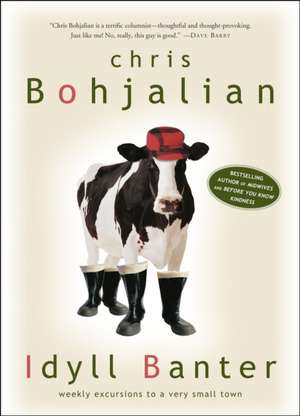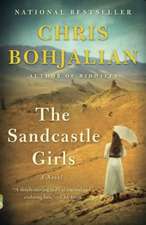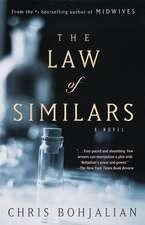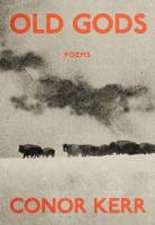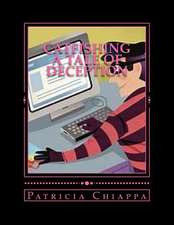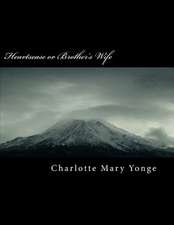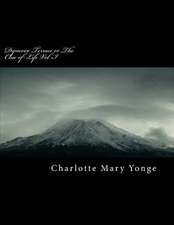Idyll Banter: Weekly Excursions to a Very Small Town
Autor Chris Bohjalianen Limba Engleză Paperback – 30 apr 2005
Preț: 123.90 lei
Nou
Puncte Express: 186
Preț estimativ în valută:
23.71€ • 25.35$ • 19.77£
23.71€ • 25.35$ • 19.77£
Carte disponibilă
Livrare economică 27 martie-10 aprilie
Preluare comenzi: 021 569.72.76
Specificații
ISBN-13: 9781400052363
ISBN-10: 140005236X
Pagini: 240
Dimensiuni: 140 x 195 x 18 mm
Greutate: 0.28 kg
Editura: BROADWAY BOOKS
ISBN-10: 140005236X
Pagini: 240
Dimensiuni: 140 x 195 x 18 mm
Greutate: 0.28 kg
Editura: BROADWAY BOOKS
Notă biografică
Chris Bohjalian is the award-winning author of nine novels, including Before You Know Kindness, The Buffalo Soldier, Trans-Sister Radio, The Law of Similars, and Midwives.
Extras
Now That the Cows Are Gone
The sun wouldn't rise for two more hours, but by 5:00 in the morning Tom Densmore was in the barn milking cows. When the trucks arrived shortly before 8:00-two the length of tractor trailers and a third perhaps half that long-he had finished milking the animals, but he hadn't begun to disassemble the feed carts or milking machines. That would have to wait until the afternoon.
It took Densmore and the truckers three hours to march his sixty-head herd up the metal ramps into the trucks, about what the thirty-four-year-old farmer had expected. By 11:30, the trucks were beginning their slow descent on the steep road that had led them up to the Vermont hill farm, winding past miles of new-growth forest, and then through the center of town, with its immaculate white church, general store, and two dozen village houses with sharply pitched roofs.
The animals arrived at the auction barn, about three hours away, in midafternoon. It took auctioneer Herb Gray less than ninety minutes to dispose of the herd, selling the milking cows one by one and some of the calves in small groups. Most of the cows brought Densmore $800 to $1,100 each, while the calves went for $200 to $700 apiece-not enough to pull him completely out of debt.
Densmore's mother, sister, and one of his brothers stood by him as his cows were scattered to farms across Vermont and New Hampshire. Nita, Nola, and Nicki-alliteration that signaled the cows were from the same family-were separated, as were three of Densmore's best producers: Kim, Amy, and Fayne. Every year they gamely produced well over 16,000 pounds of milk each.
Densmore's sixty-head herd was small even by Vermont standards, but it represented the last dairy farm in Lincoln, and the auction last December formally marked the end of an era. Lincoln, a village thirty miles southeast of Burlington, boasted forty-six active dairy farms as recently as 1945. Today there are none. There may be an occasional cluster of cows or beef cattle visible on the hillsides that roll throughout Lincoln, but there will be no more silver trucks from the Eastern Milk Producers Cooperative winding their way through town or trying to negotiate the narrow roads that link the homes in the hills.
Like many of Vermont's small rural towns, Lincoln has changed. In 1950, there were 11,019 dairy farms in Vermont. Today there are barely 2,300. The farms that remain are bigger-an average Vermont dairy farm has seventy-three milking cows, up from fifty-five as recently as 1978-and the cows produce more milk: roughly 15,500 pounds per cow per year these days, versus 11,500 pounds fifteen years ago.
Some of the farms disappeared simply because the farmers grew too old to milk fifty or sixty cows twice a day, and their children chose more lucrative occupations: carpentry or real estate or manufacturing jobs in Connecticut and Massachusetts. Other farmers got out when they discovered that while they may have been cash-poor, their land was valued by down-country immigrants: Selling a few acres a year might take care of the property taxes. And some farmers simply became frustrated by the economics of the industry. The price of milk today is unchanged from 1978, but the cost of producing that milk-everything from seed to the taxes on the land-has risen.
Some of the changes in Lincoln are immediately apparent: Meadows and pastures that once were farms have become forest. New homes have appeared in the past twelve months on both sides of the white clapboard building that houses the town clerk's office. Other changes may be harder to see, but they are no less significant: The three men and women who are Lincoln's selectmen this year are from Pittsburgh, Boston, and Grinnell, Iowa. One of them has lived in Lincoln barely two years.
What was once a largely self-contained community in which everyone worked his own land or was employed by one of the local mills that peppered the New Haven River, a community in which everyone knew how everyone else would vote at town meeting each March, has been transformed.
And it has been transformed, at least in part, by people like me. My wife and I discovered Lincoln in 1986. At the time we were living in Brooklyn, New York, in a modest apartment with windows that boasted bulletproof glass. She was a unit trust trader, and I was an advertising executive. We had grand visions of upward mobility, something we defined as a bigger apart- ment in a worse neighborhood. We knew the last names of most of our neighbors in the five-story brownstone in which we lived because we saw their names on the mailboxes, but we knew few first names, and rarely could we have matched a last name to a face.
At some point that spring, we decided to move to Vermont. I had never set foot in the state, and my wife hadn't been there since she spent a month at a summer camp near Lake Champlain. We had certainly never heard of a village called Lincoln.
But we had a shared vision of Vermont that drew us north: an image of green hills dotted with black-and-white Holsteins, an ethic of hard work that was symbolized for us by a mythic image of a barn lit before daybreak. We imagined villages in which everyone knew everyone's name and neighbors took care of one another. We imagined a place like Lincoln.
Lincoln sits in a valley midway up Mount Abraham, a 4,000-foot mountain, at an elevation of about 1,200 feet. Geography is destiny here. People do not stumble upon the town by accident or because they are driving between Burlington and Rutland. The center of Lincoln is located three miles off a two-lane road that continues thirty miles northwest into Burlington. The road to Lincoln coils uphill, twisting through rocky hills thick with maple and pine and ash.
Residents take pride in the town's isolation and in the fact that its growing season is ten days shorter than Bristol's, a village only four miles away but situated at a much lower elevation. Some years, there are midsummer frosts heavy enough to kill young pumpkins the size of softballs.
Mount Abraham, known once as Potato Hill, towers over Lincoln and is shaped more like a toppled peach than a potato. The population of the town is about 975 people, an increase of 100 residents since 1980 but still well below the 1,400 people who lived here a century ago. By the time my wife and I arrived in Lincoln, most of the dairy farms were already gone, but there were still enough cows that the place could be mistaken for a farming community by someone who didn't know better.
There were three dairy farmers in town in 1986. There was Tom Densmore, who was renting a hundred acres from Paul Goodyear, land that Paul and his wife, Wanda, had farmed since 1945. There was Herb Parker, with fifty cows and fifty heifers, who somehow managed to cut hay in fields steep enough for a ski slope. And there was Norman Strickholm, a man in his early thirties who was renting land for his cows from retired farmers Fletcher and Harriett Brown-land that, according to the Browns, Robert Frost had once offered to buy.
The road turns to dirt as it passes Paul and Wanda Goodyear's farm. It continues upward toward the Lincoln Gap and over the mountain to Warren, but it isn't plowed in the winter and becomes impassable sometime around Halloween. In the winter, the Goodyears really do live at the end of the road.
Paul Goodyear arrived in Lincoln in 1945, bringing with him ten cows and a pair of horses from Hancock, a town about one-third the size of Lincoln, on the other side of the mountain. He paid $1,600 for 167 acres, a farmhouse, and a barn. According to the town appraisal, his property is worth $209,000 today. For forty years Paul and Wanda ran a dairy farm in the shadow of Mount Abraham, usually with about fifty cows. Their farmhouse looks out on meadows that are already becoming overgrown with brush. "In 1945, the farms were everywhere," Paul Goodyear says. "Back then, most everybody had a few cows. People didn't go to Bristol or Burlington to work." The town had its own creamery, and there was a dairy only fifteen miles away in Starksboro.
While farms have been steadily disappearing in Vermont since the end of World War II, Goodyear witnessed most of Lincoln's farmers give up dairying in the early 1960s, when the milk can was replaced by the bulk tank. Instead of filling large cans with their milk, farmers were asked by the dairies to buy and install refrigerated tanks to store the milk so the handlers could pick it up in large tanker trucks.
"The biggest drop-off was probably 1963, when we all had to put in the bulk tanks," Goodyear says. "They cost $1,200, which was a lot of money back then, plus we had to build a new milk house for it. That cost another $2,000. I guess there were twenty or twenty-five of us farming here before bulk tanks. Only five of us decided to stay in after."
Now in their sixties and seventies, the Goodyears have no less affection for Lincoln than they had when they were young. But there are moments when they no longer recognize the town in which they raised six children. "We don't know each other as well as a community," Paul says. "We can't. People keep coming in, and we don't know who they are. There are more people in the choir now than there used to be in the whole church."
Thirty-five years ago, neighbors would visit the Goodyears' farmhouse without an invitation and stay for supper, which suited Wanda just fine. "Anyone would drop in for a meal, no one would feel a need to call ahead," she says. "It was wonderful. Of course, no one would dare do that now. They' d be embarrassed-or think it was an imposition."
At different times over the last five decades, Paul has been a selectman, an auditor, and the town fire warden. As the town has grown, he believes a volunteer ethic has been lost. "We were all for one and one for all. If anyone had a calamity, a whole gang would join in and solve the problem," he says, quickly citing two examples. When his corn silo blew down in a 1949 windstorm, he and a dozen friends built a new one within days; in the fall of 1961, when he broke an arm, fifteen neighbors descended upon his farm with tractors and chain saws and cut the wood his family would need for the winter.
The Goodyears stopped farming in 1985. Only one of their children was interested in farming, and he had already established a farm elsewhere. "It wasn't economical to farm, so most everyone went on to do other things," Wanda says. They were relieved when Tom Densmore, then in his mid-twenties, asked if he could rent their land; for seven more years their farm remained active and alive.
Herb Parker stands in the backyard of his farmhouse and sweeps his arm over the hillsides that surround him to the west, the north, and the east, and he ticks off names of families who own farms. "Buss. Reynolds. Perfect. Way up there: Goodyear. It's all forest now. But it used to be clear. It used to be mowed," he says. "I miss that. I miss those farms."
Parker and his wife, Lois, ran a dairy farm on land that had been in his family for more than a century. In 1987, well into their fifties, they sold their hundred-cow herd in the federal government's Whole Herd Buyout program-an attempt to boost milk prices by decreasing supply. Until that day, Parker boasts, he had gone thirty-four consecutive years without missing a milking. "The day after we sold the cows," he says, "we regretted it. It was fun not having them around for about a week, but then we started missing them. The days and nights seemed awfully long after we got rid of them."
Today the Parkers have the closest thing to a dairy-size herd left in Lincoln. They raise beef cattle and have up to a hundred animals on their farm at any one time. "But it's not like it once was," Herb says. "Dairy farming and sugaring used to tie us all together." Like the Goodyears, the Parkers feel like strangers in Lincoln's town center. "I go to town meetings now and I don't know most of the people," Herb says. Lois adds, "You feel like an outsider because there are so many out-of-state people."
The first real influx of out-of-state people arrived in Lincoln in the early 1970s, including a group of Middlebury College students who discovered the hill town sixteen miles northeast of the campus and started buying acres of cheap land. Some built geodesic domes or restored farmhouses. Some married, had children, and helped start a preschool.
Today there are still a half-dozen homes filled with these "alfalfa sprouts," as one elderly farmer describes them. One of them, Cynthia Price, is a nationally recognized painter who has spent a decade interpreting on canvas something she calls an "endangered species"-the barn. Her home is on the edge of what was once a thriving dairy farm run by James Moody, who stopped farming in the mid-'70s and died two years ago. "Jim's barns were so important to him. They're falling apart now," Price says, "but they're still incredibly beautiful."
A for-sale sign appeared in the yard by Moody's empty farmhouse in April, and Price fears that she's going to wake up one morning and find his barns gone, replaced by a housing development.
Like Herb Parker, James Moody subscribed to a rural aesthetic that prized field over forest. For a full decade after his animals were gone, he climbed onto his tractor and hayed his fields. Price says that some of her friends- "us flatlander hippies"-brought controversy to Lincoln: Their desire for a preschool may have been more controversial with the old-timers than the sight of young men with ponytails; their belief that the center elementary school had to be improved was almost insulting.
The elementary school was built by volunteer labor-farmers who found time between haying and milking-in 1952, after an earlier schoolhouse burned down. In 1978, when the proposal to establish a public kindergarten was rejected at a town meeting, the young parents who had been running a preschool in the town hall raised money to construct their own building.
Price says that while the old-timers may have occasionally smirked at the colony of Middlebury alumni and their friends, they tended to take individuals in the group under their wing. Kim Smith remembers buying land from a local building excavator, Floyd Hall, in 1972: "He could have really stuck it to me if he'd wanted to, but he didn't. I was this twenty-two-year-old college kid from the Midwest who had some money, and I had no idea what land was supposed to cost. But Floyd charged me what I've since come to realize was a fair price. It was the same way when he put in my driveway. He's just a real honest guy."
Even though he wears his hair long and brought vegetarian falafel burgers to the A & W in Middlebury after he bought the restaurant, Smith has been consistently elected to the town school board since the mid-1980s. There is often heated debate at town meetings about the rising cost of education, but "we've never had a school budget defeated," he says proudly. "This community has always been very supportive."
While the barns in the hills may be decaying, the center of town had a dramatic face-lift in the 1980s. "Downtown Lincoln wasn't so picturesque when I got here in the early 1970s," Price recalls.
When most Vermont towns are gentrified, the impetus-and the funding-is likely to come from newcomers. Lincoln is an exception. What Price calls the "beautification of the downtown" began with a tragedy and was led by families with Lincoln pedigrees dating back well into the last century.
In 1981, on the night of Good Friday, a gas leak in the United Church of Lincoln sparked a fire that reduced the only active church in town to ashes. About all that remained of the century-old Protestant church was the steel weathervane that rose from the top of the steeple. The church had rested on a small rise, at one of the four corners where Lincoln's two main roads intersect, the literal and metaphoric heart of the town. When Easter Sunday services were held that year at the town hall, diagonally across the street from the hillside where the church had been, the parishioners looked out windows toward the still smoldering ashes, and many of them wept.
Rev. David Wood and his wife, Donna, had arrived in town only two years earlier, and were still getting to know the congregation when the church went up in flames. They were a couple in their late twenties with two young children. "A lot of people thought David would just turn around and leave when the church burned," Donna says. "But I knew he wouldn't. I knew we wouldn't."
About half a mile from the center of town was the old Methodist church building, which for decades had stood vacant. While it might have been easier to simply rededicate the church for ecumenical Protestant services, the fire had left a hole in the center of town more pronounced than the loss, perhaps, of a whole city block in the middle of Boston.
"Imagine driving up the road to Lincoln and finding that hill empty," says Beverly Brown. Brown grew up beside the church and owned the general store across the street with her husband, Donald, for almost fifteen years.
The congregation raised the money it needed to move the old Methodist church a half-mile, drop it in place on the hillside, and restore it. The effort cost $164,000-and thousands of hours in volunteer labor. While half of the money came from insurance, another half was raised by the congregation through venison suppers, bake sales, and hundreds of letters requesting grants and private donations.
Bill Finger, who spent summers in Lincoln as a boy and moved to the town permanently in 1974, recalls, "That fire galvanized the church and the community. A lot of people still feel it was an act of God that in the long run brought a lot of people together."
The congregation completed the restoration of the church in 1983, and, motivated by what Paul and Wanda Goodyear's daughter Linda Norton describes as "the desire to give something back," a second restoration project was begun. A group of parishioners raised money to buy two houses across the street from the church, one on the verge of collapse, and convert them to use as affordable housing for the community's elderly. Today, the housing complex consists of ten separate apartments in three buildings, all of which look like well-kept private homes.
That project cost $250,000-not including volunteer carpentry, wallpapering, and painting-and transformed the four corners that comprise Lincoln center into the sort of idyllic picture postcard that entices advertising executives and unit trust traders away from New York.
Cynthia Price's nightmare-waking up to find the barns next door replaced by a development-could happen. But it's not likely. The town has safeguards to prevent such things. With the exception of the apartments for the elderly, the town does not allow new homes to be constructed on lots smaller than one acre.
But as the farmers sell off their land, there is no question that houses do appear. Ivis and Stewart Masterson farmed in South Lincoln for three decades before calling it quits in 1968. At one point they owned 275 acres. Today they own less than two. "We started selling off the land thirty years ago, and people started building houses," Ivis says. "There are so many more people now." At least fourteen houses dot the land that was once the Masterson farm. Adjacent to that land is an eight-house development.
Although the first influx of out-of-state people was hippies, the second influx was young professionals who chose not to settle in cities. Flatlanders like my wife and me began arriving in the 1980s; many of them now commute to Burlington or Middlebury or Vergennes.
Karen Lueders and her husband, Jim DuMont, are both attorneys. She is from Boston, he is from New York City, and they are raising their three children in a farmhouse near land that until recently Norman Strickholm was maintaining as one of the two active dairy farms in Lincoln.
"Everything that happened to us here was touched by kindness," Lueders says, recalling 1986, her family's first year in Lincoln. When part of the roof blew off their house one Christmas when they were gone, their neighbors immediately repaired it; when they failed to make arrangements to have their long driveway plowed before the first blizzard, Strickholm cleared the snow at no charge.
Lueders would take her young children and wander to the farm to watch Strickholm milk his Ayrshire cows. In 1991, Strickholm moved his herd to Colorado, where land is cheaper and where he thought dairying would be more profitable. "Norman's leaving was traumatic for our family," Lueders says. "Just knowing he was out there milking the cows was a part of our life."
Like Strickholm, Ivis Masterson farmed Lincoln's rocky soil, and she understands why none of her five children chose to continue the family's dairy tradition: "They knew the hardship of our lives. They knew there was little money. All five of the kids have a better life than we had."
Although Masterson misses the quiet farm life, she appreciates that many newcomers contribute to the community: "I know there's an awful lot of young people out there who've come here and tied this place together the way we once did with the farms." The Mastersons did not sell all of their land; they gave some of it to their children who have remained in town.
Four of the Mastersons' five children stayed in Lincoln, an important dynamic in a town bonded in part by multigenerational families. All of Donald and Beverly Brown's three sons have remained, as has Fletcher and Harriett Brown's daughter.
"Unlike suburbia, where there are whole neighborhoods of people the same age, there are a lot of different generations within each family still here in Lincoln," Beverly Brown says. At any moment on a Sunday morning in church, it is possible for me to see a host of Browns: Jim and Judy, as they sing in the choir; Harriett, a deacon, passing the offering plate along the pews; Beverly, tracking down a cassette tape of the service so that the elderly who can't make it to church are able to hear what they missed; and brothers Fletcher and Donald, deep in conversation before the bells have rung and called them to their pews, discussing, perhaps, the spring sugar run.
I am always moved when I see the Browns together in church-more now than seven years ago, when I failed to understand the complex blood network that links one of Lincoln's first families. I never went to church in Brooklyn, and I started attending in Lincoln only when Fletcher Brown commented on the fact that my house and the church share the same driveway. Noting my unique proximity to the sanctuary-forty yards, closer than the parsonage-Fletcher said, in his wry and unmistakably understated voice, "Don't have much of an excuse not to go to church now, do you?"
Shame first brought me there, but fellowship and faith have led me to stay.
The farms may have left Lincoln, but the sense of community hasn't. There is no question that the town has changed, that the influx of new people has transformed a once self-contained rural community into something vaguely suburban. Each weekday morning, a lot of Lincoln winds its way down the road that milk tankers once took, and I wouldn't be surprised to find a stoplight someday where the road to Lincoln meets the road to Burlington.
Clearly the town lost something when it lost its farms, but sometimes I'm not sure it lost anything more substantial than cows. That sounds glib, but it may also be true. Alice Leeds teaches fifth and sixth grade at the elementary school. She has taught in rural communities in the South, she has taught in midtown Manhattan. Inspired this spring by the case of the Chicago parents who left their two young children home alone while they took a Caribbean vacation, Leeds devoted class time to the ethical issues of leaving children unsupervised. What her students told her surprised her.
"Most of the kids-two-thirds-said they're never scared when they're home alone," Leeds says. "People feel responsible for each other here, and the kids understand that Lincoln is their place. They're comfortable here, they feel safe here."
If I worried for Lincoln's soul, those concerns were eased at the funeral service this May for Tari Shattuck, a forty-one-year-old neighbor who died of leukemia. Shattuck was born in Paris and raised in Texas. She arrived in Lincoln in 1972, a Democrat in a Republican hill town. Among the women and men who spoke at her service-at which every seat was filled and some mourners had to view the eulogy on video monitors set up in the Sunday-school classrooms-was Fred Thompson.
Thompson's Lincoln roots date back to the nineteenth century. He is a conservative Yankee, tough at town meetings, skeptical of most budget initiatives. He served with Shattuck on the town planning commission in the early 1980s, a fact I never knew until he began to speak at the front of the church on the day of her funeral.
"If any of you want to know how much Tari Shattuck loved this town, how much she cared for all of you, go to the town clerk's office and take a look at the town plan she wrote," Thompson said, and then his voice broke abruptly. He might have planned to say more, but if he did he changed his mind, and he started back to his seat. "A flaming liberal!" he said, shaking his head in mock disgust, and I saw some of her family smile through their tears.
I had found a seat in the choir loft before the service began, so I had the opportunity to see a lot of faces that afternoon: aging hippies with beards and bad neckties, some of the women in peasant skirts; elderly farmers wiping their eyeglasses; teachers from the local school; selectmen past and present; choir members sitting for once in the pews. I saw Goodyears and Nortons and Browns; I saw three generations of families scattered across the church like wildflower seeds.
I saw more of the town together than I've seen even at a town meeting. I saw Lincoln, once again, looking out for its own.
From the Hardcover edition.
The sun wouldn't rise for two more hours, but by 5:00 in the morning Tom Densmore was in the barn milking cows. When the trucks arrived shortly before 8:00-two the length of tractor trailers and a third perhaps half that long-he had finished milking the animals, but he hadn't begun to disassemble the feed carts or milking machines. That would have to wait until the afternoon.
It took Densmore and the truckers three hours to march his sixty-head herd up the metal ramps into the trucks, about what the thirty-four-year-old farmer had expected. By 11:30, the trucks were beginning their slow descent on the steep road that had led them up to the Vermont hill farm, winding past miles of new-growth forest, and then through the center of town, with its immaculate white church, general store, and two dozen village houses with sharply pitched roofs.
The animals arrived at the auction barn, about three hours away, in midafternoon. It took auctioneer Herb Gray less than ninety minutes to dispose of the herd, selling the milking cows one by one and some of the calves in small groups. Most of the cows brought Densmore $800 to $1,100 each, while the calves went for $200 to $700 apiece-not enough to pull him completely out of debt.
Densmore's mother, sister, and one of his brothers stood by him as his cows were scattered to farms across Vermont and New Hampshire. Nita, Nola, and Nicki-alliteration that signaled the cows were from the same family-were separated, as were three of Densmore's best producers: Kim, Amy, and Fayne. Every year they gamely produced well over 16,000 pounds of milk each.
Densmore's sixty-head herd was small even by Vermont standards, but it represented the last dairy farm in Lincoln, and the auction last December formally marked the end of an era. Lincoln, a village thirty miles southeast of Burlington, boasted forty-six active dairy farms as recently as 1945. Today there are none. There may be an occasional cluster of cows or beef cattle visible on the hillsides that roll throughout Lincoln, but there will be no more silver trucks from the Eastern Milk Producers Cooperative winding their way through town or trying to negotiate the narrow roads that link the homes in the hills.
Like many of Vermont's small rural towns, Lincoln has changed. In 1950, there were 11,019 dairy farms in Vermont. Today there are barely 2,300. The farms that remain are bigger-an average Vermont dairy farm has seventy-three milking cows, up from fifty-five as recently as 1978-and the cows produce more milk: roughly 15,500 pounds per cow per year these days, versus 11,500 pounds fifteen years ago.
Some of the farms disappeared simply because the farmers grew too old to milk fifty or sixty cows twice a day, and their children chose more lucrative occupations: carpentry or real estate or manufacturing jobs in Connecticut and Massachusetts. Other farmers got out when they discovered that while they may have been cash-poor, their land was valued by down-country immigrants: Selling a few acres a year might take care of the property taxes. And some farmers simply became frustrated by the economics of the industry. The price of milk today is unchanged from 1978, but the cost of producing that milk-everything from seed to the taxes on the land-has risen.
Some of the changes in Lincoln are immediately apparent: Meadows and pastures that once were farms have become forest. New homes have appeared in the past twelve months on both sides of the white clapboard building that houses the town clerk's office. Other changes may be harder to see, but they are no less significant: The three men and women who are Lincoln's selectmen this year are from Pittsburgh, Boston, and Grinnell, Iowa. One of them has lived in Lincoln barely two years.
What was once a largely self-contained community in which everyone worked his own land or was employed by one of the local mills that peppered the New Haven River, a community in which everyone knew how everyone else would vote at town meeting each March, has been transformed.
And it has been transformed, at least in part, by people like me. My wife and I discovered Lincoln in 1986. At the time we were living in Brooklyn, New York, in a modest apartment with windows that boasted bulletproof glass. She was a unit trust trader, and I was an advertising executive. We had grand visions of upward mobility, something we defined as a bigger apart- ment in a worse neighborhood. We knew the last names of most of our neighbors in the five-story brownstone in which we lived because we saw their names on the mailboxes, but we knew few first names, and rarely could we have matched a last name to a face.
At some point that spring, we decided to move to Vermont. I had never set foot in the state, and my wife hadn't been there since she spent a month at a summer camp near Lake Champlain. We had certainly never heard of a village called Lincoln.
But we had a shared vision of Vermont that drew us north: an image of green hills dotted with black-and-white Holsteins, an ethic of hard work that was symbolized for us by a mythic image of a barn lit before daybreak. We imagined villages in which everyone knew everyone's name and neighbors took care of one another. We imagined a place like Lincoln.
Lincoln sits in a valley midway up Mount Abraham, a 4,000-foot mountain, at an elevation of about 1,200 feet. Geography is destiny here. People do not stumble upon the town by accident or because they are driving between Burlington and Rutland. The center of Lincoln is located three miles off a two-lane road that continues thirty miles northwest into Burlington. The road to Lincoln coils uphill, twisting through rocky hills thick with maple and pine and ash.
Residents take pride in the town's isolation and in the fact that its growing season is ten days shorter than Bristol's, a village only four miles away but situated at a much lower elevation. Some years, there are midsummer frosts heavy enough to kill young pumpkins the size of softballs.
Mount Abraham, known once as Potato Hill, towers over Lincoln and is shaped more like a toppled peach than a potato. The population of the town is about 975 people, an increase of 100 residents since 1980 but still well below the 1,400 people who lived here a century ago. By the time my wife and I arrived in Lincoln, most of the dairy farms were already gone, but there were still enough cows that the place could be mistaken for a farming community by someone who didn't know better.
There were three dairy farmers in town in 1986. There was Tom Densmore, who was renting a hundred acres from Paul Goodyear, land that Paul and his wife, Wanda, had farmed since 1945. There was Herb Parker, with fifty cows and fifty heifers, who somehow managed to cut hay in fields steep enough for a ski slope. And there was Norman Strickholm, a man in his early thirties who was renting land for his cows from retired farmers Fletcher and Harriett Brown-land that, according to the Browns, Robert Frost had once offered to buy.
The road turns to dirt as it passes Paul and Wanda Goodyear's farm. It continues upward toward the Lincoln Gap and over the mountain to Warren, but it isn't plowed in the winter and becomes impassable sometime around Halloween. In the winter, the Goodyears really do live at the end of the road.
Paul Goodyear arrived in Lincoln in 1945, bringing with him ten cows and a pair of horses from Hancock, a town about one-third the size of Lincoln, on the other side of the mountain. He paid $1,600 for 167 acres, a farmhouse, and a barn. According to the town appraisal, his property is worth $209,000 today. For forty years Paul and Wanda ran a dairy farm in the shadow of Mount Abraham, usually with about fifty cows. Their farmhouse looks out on meadows that are already becoming overgrown with brush. "In 1945, the farms were everywhere," Paul Goodyear says. "Back then, most everybody had a few cows. People didn't go to Bristol or Burlington to work." The town had its own creamery, and there was a dairy only fifteen miles away in Starksboro.
While farms have been steadily disappearing in Vermont since the end of World War II, Goodyear witnessed most of Lincoln's farmers give up dairying in the early 1960s, when the milk can was replaced by the bulk tank. Instead of filling large cans with their milk, farmers were asked by the dairies to buy and install refrigerated tanks to store the milk so the handlers could pick it up in large tanker trucks.
"The biggest drop-off was probably 1963, when we all had to put in the bulk tanks," Goodyear says. "They cost $1,200, which was a lot of money back then, plus we had to build a new milk house for it. That cost another $2,000. I guess there were twenty or twenty-five of us farming here before bulk tanks. Only five of us decided to stay in after."
Now in their sixties and seventies, the Goodyears have no less affection for Lincoln than they had when they were young. But there are moments when they no longer recognize the town in which they raised six children. "We don't know each other as well as a community," Paul says. "We can't. People keep coming in, and we don't know who they are. There are more people in the choir now than there used to be in the whole church."
Thirty-five years ago, neighbors would visit the Goodyears' farmhouse without an invitation and stay for supper, which suited Wanda just fine. "Anyone would drop in for a meal, no one would feel a need to call ahead," she says. "It was wonderful. Of course, no one would dare do that now. They' d be embarrassed-or think it was an imposition."
At different times over the last five decades, Paul has been a selectman, an auditor, and the town fire warden. As the town has grown, he believes a volunteer ethic has been lost. "We were all for one and one for all. If anyone had a calamity, a whole gang would join in and solve the problem," he says, quickly citing two examples. When his corn silo blew down in a 1949 windstorm, he and a dozen friends built a new one within days; in the fall of 1961, when he broke an arm, fifteen neighbors descended upon his farm with tractors and chain saws and cut the wood his family would need for the winter.
The Goodyears stopped farming in 1985. Only one of their children was interested in farming, and he had already established a farm elsewhere. "It wasn't economical to farm, so most everyone went on to do other things," Wanda says. They were relieved when Tom Densmore, then in his mid-twenties, asked if he could rent their land; for seven more years their farm remained active and alive.
Herb Parker stands in the backyard of his farmhouse and sweeps his arm over the hillsides that surround him to the west, the north, and the east, and he ticks off names of families who own farms. "Buss. Reynolds. Perfect. Way up there: Goodyear. It's all forest now. But it used to be clear. It used to be mowed," he says. "I miss that. I miss those farms."
Parker and his wife, Lois, ran a dairy farm on land that had been in his family for more than a century. In 1987, well into their fifties, they sold their hundred-cow herd in the federal government's Whole Herd Buyout program-an attempt to boost milk prices by decreasing supply. Until that day, Parker boasts, he had gone thirty-four consecutive years without missing a milking. "The day after we sold the cows," he says, "we regretted it. It was fun not having them around for about a week, but then we started missing them. The days and nights seemed awfully long after we got rid of them."
Today the Parkers have the closest thing to a dairy-size herd left in Lincoln. They raise beef cattle and have up to a hundred animals on their farm at any one time. "But it's not like it once was," Herb says. "Dairy farming and sugaring used to tie us all together." Like the Goodyears, the Parkers feel like strangers in Lincoln's town center. "I go to town meetings now and I don't know most of the people," Herb says. Lois adds, "You feel like an outsider because there are so many out-of-state people."
The first real influx of out-of-state people arrived in Lincoln in the early 1970s, including a group of Middlebury College students who discovered the hill town sixteen miles northeast of the campus and started buying acres of cheap land. Some built geodesic domes or restored farmhouses. Some married, had children, and helped start a preschool.
Today there are still a half-dozen homes filled with these "alfalfa sprouts," as one elderly farmer describes them. One of them, Cynthia Price, is a nationally recognized painter who has spent a decade interpreting on canvas something she calls an "endangered species"-the barn. Her home is on the edge of what was once a thriving dairy farm run by James Moody, who stopped farming in the mid-'70s and died two years ago. "Jim's barns were so important to him. They're falling apart now," Price says, "but they're still incredibly beautiful."
A for-sale sign appeared in the yard by Moody's empty farmhouse in April, and Price fears that she's going to wake up one morning and find his barns gone, replaced by a housing development.
Like Herb Parker, James Moody subscribed to a rural aesthetic that prized field over forest. For a full decade after his animals were gone, he climbed onto his tractor and hayed his fields. Price says that some of her friends- "us flatlander hippies"-brought controversy to Lincoln: Their desire for a preschool may have been more controversial with the old-timers than the sight of young men with ponytails; their belief that the center elementary school had to be improved was almost insulting.
The elementary school was built by volunteer labor-farmers who found time between haying and milking-in 1952, after an earlier schoolhouse burned down. In 1978, when the proposal to establish a public kindergarten was rejected at a town meeting, the young parents who had been running a preschool in the town hall raised money to construct their own building.
Price says that while the old-timers may have occasionally smirked at the colony of Middlebury alumni and their friends, they tended to take individuals in the group under their wing. Kim Smith remembers buying land from a local building excavator, Floyd Hall, in 1972: "He could have really stuck it to me if he'd wanted to, but he didn't. I was this twenty-two-year-old college kid from the Midwest who had some money, and I had no idea what land was supposed to cost. But Floyd charged me what I've since come to realize was a fair price. It was the same way when he put in my driveway. He's just a real honest guy."
Even though he wears his hair long and brought vegetarian falafel burgers to the A & W in Middlebury after he bought the restaurant, Smith has been consistently elected to the town school board since the mid-1980s. There is often heated debate at town meetings about the rising cost of education, but "we've never had a school budget defeated," he says proudly. "This community has always been very supportive."
While the barns in the hills may be decaying, the center of town had a dramatic face-lift in the 1980s. "Downtown Lincoln wasn't so picturesque when I got here in the early 1970s," Price recalls.
When most Vermont towns are gentrified, the impetus-and the funding-is likely to come from newcomers. Lincoln is an exception. What Price calls the "beautification of the downtown" began with a tragedy and was led by families with Lincoln pedigrees dating back well into the last century.
In 1981, on the night of Good Friday, a gas leak in the United Church of Lincoln sparked a fire that reduced the only active church in town to ashes. About all that remained of the century-old Protestant church was the steel weathervane that rose from the top of the steeple. The church had rested on a small rise, at one of the four corners where Lincoln's two main roads intersect, the literal and metaphoric heart of the town. When Easter Sunday services were held that year at the town hall, diagonally across the street from the hillside where the church had been, the parishioners looked out windows toward the still smoldering ashes, and many of them wept.
Rev. David Wood and his wife, Donna, had arrived in town only two years earlier, and were still getting to know the congregation when the church went up in flames. They were a couple in their late twenties with two young children. "A lot of people thought David would just turn around and leave when the church burned," Donna says. "But I knew he wouldn't. I knew we wouldn't."
About half a mile from the center of town was the old Methodist church building, which for decades had stood vacant. While it might have been easier to simply rededicate the church for ecumenical Protestant services, the fire had left a hole in the center of town more pronounced than the loss, perhaps, of a whole city block in the middle of Boston.
"Imagine driving up the road to Lincoln and finding that hill empty," says Beverly Brown. Brown grew up beside the church and owned the general store across the street with her husband, Donald, for almost fifteen years.
The congregation raised the money it needed to move the old Methodist church a half-mile, drop it in place on the hillside, and restore it. The effort cost $164,000-and thousands of hours in volunteer labor. While half of the money came from insurance, another half was raised by the congregation through venison suppers, bake sales, and hundreds of letters requesting grants and private donations.
Bill Finger, who spent summers in Lincoln as a boy and moved to the town permanently in 1974, recalls, "That fire galvanized the church and the community. A lot of people still feel it was an act of God that in the long run brought a lot of people together."
The congregation completed the restoration of the church in 1983, and, motivated by what Paul and Wanda Goodyear's daughter Linda Norton describes as "the desire to give something back," a second restoration project was begun. A group of parishioners raised money to buy two houses across the street from the church, one on the verge of collapse, and convert them to use as affordable housing for the community's elderly. Today, the housing complex consists of ten separate apartments in three buildings, all of which look like well-kept private homes.
That project cost $250,000-not including volunteer carpentry, wallpapering, and painting-and transformed the four corners that comprise Lincoln center into the sort of idyllic picture postcard that entices advertising executives and unit trust traders away from New York.
Cynthia Price's nightmare-waking up to find the barns next door replaced by a development-could happen. But it's not likely. The town has safeguards to prevent such things. With the exception of the apartments for the elderly, the town does not allow new homes to be constructed on lots smaller than one acre.
But as the farmers sell off their land, there is no question that houses do appear. Ivis and Stewart Masterson farmed in South Lincoln for three decades before calling it quits in 1968. At one point they owned 275 acres. Today they own less than two. "We started selling off the land thirty years ago, and people started building houses," Ivis says. "There are so many more people now." At least fourteen houses dot the land that was once the Masterson farm. Adjacent to that land is an eight-house development.
Although the first influx of out-of-state people was hippies, the second influx was young professionals who chose not to settle in cities. Flatlanders like my wife and me began arriving in the 1980s; many of them now commute to Burlington or Middlebury or Vergennes.
Karen Lueders and her husband, Jim DuMont, are both attorneys. She is from Boston, he is from New York City, and they are raising their three children in a farmhouse near land that until recently Norman Strickholm was maintaining as one of the two active dairy farms in Lincoln.
"Everything that happened to us here was touched by kindness," Lueders says, recalling 1986, her family's first year in Lincoln. When part of the roof blew off their house one Christmas when they were gone, their neighbors immediately repaired it; when they failed to make arrangements to have their long driveway plowed before the first blizzard, Strickholm cleared the snow at no charge.
Lueders would take her young children and wander to the farm to watch Strickholm milk his Ayrshire cows. In 1991, Strickholm moved his herd to Colorado, where land is cheaper and where he thought dairying would be more profitable. "Norman's leaving was traumatic for our family," Lueders says. "Just knowing he was out there milking the cows was a part of our life."
Like Strickholm, Ivis Masterson farmed Lincoln's rocky soil, and she understands why none of her five children chose to continue the family's dairy tradition: "They knew the hardship of our lives. They knew there was little money. All five of the kids have a better life than we had."
Although Masterson misses the quiet farm life, she appreciates that many newcomers contribute to the community: "I know there's an awful lot of young people out there who've come here and tied this place together the way we once did with the farms." The Mastersons did not sell all of their land; they gave some of it to their children who have remained in town.
Four of the Mastersons' five children stayed in Lincoln, an important dynamic in a town bonded in part by multigenerational families. All of Donald and Beverly Brown's three sons have remained, as has Fletcher and Harriett Brown's daughter.
"Unlike suburbia, where there are whole neighborhoods of people the same age, there are a lot of different generations within each family still here in Lincoln," Beverly Brown says. At any moment on a Sunday morning in church, it is possible for me to see a host of Browns: Jim and Judy, as they sing in the choir; Harriett, a deacon, passing the offering plate along the pews; Beverly, tracking down a cassette tape of the service so that the elderly who can't make it to church are able to hear what they missed; and brothers Fletcher and Donald, deep in conversation before the bells have rung and called them to their pews, discussing, perhaps, the spring sugar run.
I am always moved when I see the Browns together in church-more now than seven years ago, when I failed to understand the complex blood network that links one of Lincoln's first families. I never went to church in Brooklyn, and I started attending in Lincoln only when Fletcher Brown commented on the fact that my house and the church share the same driveway. Noting my unique proximity to the sanctuary-forty yards, closer than the parsonage-Fletcher said, in his wry and unmistakably understated voice, "Don't have much of an excuse not to go to church now, do you?"
Shame first brought me there, but fellowship and faith have led me to stay.
The farms may have left Lincoln, but the sense of community hasn't. There is no question that the town has changed, that the influx of new people has transformed a once self-contained rural community into something vaguely suburban. Each weekday morning, a lot of Lincoln winds its way down the road that milk tankers once took, and I wouldn't be surprised to find a stoplight someday where the road to Lincoln meets the road to Burlington.
Clearly the town lost something when it lost its farms, but sometimes I'm not sure it lost anything more substantial than cows. That sounds glib, but it may also be true. Alice Leeds teaches fifth and sixth grade at the elementary school. She has taught in rural communities in the South, she has taught in midtown Manhattan. Inspired this spring by the case of the Chicago parents who left their two young children home alone while they took a Caribbean vacation, Leeds devoted class time to the ethical issues of leaving children unsupervised. What her students told her surprised her.
"Most of the kids-two-thirds-said they're never scared when they're home alone," Leeds says. "People feel responsible for each other here, and the kids understand that Lincoln is their place. They're comfortable here, they feel safe here."
If I worried for Lincoln's soul, those concerns were eased at the funeral service this May for Tari Shattuck, a forty-one-year-old neighbor who died of leukemia. Shattuck was born in Paris and raised in Texas. She arrived in Lincoln in 1972, a Democrat in a Republican hill town. Among the women and men who spoke at her service-at which every seat was filled and some mourners had to view the eulogy on video monitors set up in the Sunday-school classrooms-was Fred Thompson.
Thompson's Lincoln roots date back to the nineteenth century. He is a conservative Yankee, tough at town meetings, skeptical of most budget initiatives. He served with Shattuck on the town planning commission in the early 1980s, a fact I never knew until he began to speak at the front of the church on the day of her funeral.
"If any of you want to know how much Tari Shattuck loved this town, how much she cared for all of you, go to the town clerk's office and take a look at the town plan she wrote," Thompson said, and then his voice broke abruptly. He might have planned to say more, but if he did he changed his mind, and he started back to his seat. "A flaming liberal!" he said, shaking his head in mock disgust, and I saw some of her family smile through their tears.
I had found a seat in the choir loft before the service began, so I had the opportunity to see a lot of faces that afternoon: aging hippies with beards and bad neckties, some of the women in peasant skirts; elderly farmers wiping their eyeglasses; teachers from the local school; selectmen past and present; choir members sitting for once in the pews. I saw Goodyears and Nortons and Browns; I saw three generations of families scattered across the church like wildflower seeds.
I saw more of the town together than I've seen even at a town meeting. I saw Lincoln, once again, looking out for its own.
From the Hardcover edition.
Recenzii
“Chris Bohjalian is a terrific columnist—thoughtful and thought-provoking. Just like me! No, really, this guy is good.” —Dave Barry
“[Bohjalian] is writing about one of the most important issues in America today—how do we retain our sense of community. . . . Gentle . . . sensitive . . .heart-warming.” —Ft. Lauderdale Sun-Sentinel
“These essays carry a community connection and a humble grace. When words read this easily, you know they also carry a lot of work. Bohjalian is a reliable guide, moving from pastures to town steeple to the edge of the playground.” —Boston Globe
“Whether you’re aching to escape the urban grind or yearning to have your small-town experience reflected back at you, you’ll do well to pick up Idyll Banter.” —Elle
“[Bohjalian] is writing about one of the most important issues in America today—how do we retain our sense of community. . . . Gentle . . . sensitive . . .heart-warming.” —Ft. Lauderdale Sun-Sentinel
“These essays carry a community connection and a humble grace. When words read this easily, you know they also carry a lot of work. Bohjalian is a reliable guide, moving from pastures to town steeple to the edge of the playground.” —Boston Globe
“Whether you’re aching to escape the urban grind or yearning to have your small-town experience reflected back at you, you’ll do well to pick up Idyll Banter.” —Elle
